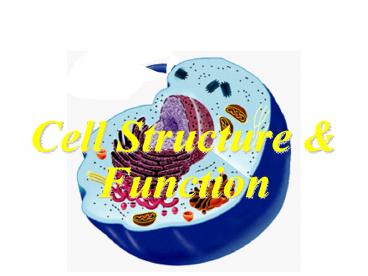Cell Structure - PowerPoint PPT Presentation
1 / 27
Title:
Cell Structure
Description:
protists: contractile vacuole for fluid excretion (primitive kidney!) Vacuoles. Vacuoles ... allows plant cells to be relatively large, yet to have very little ... – PowerPoint PPT presentation
Number of Views:48
Avg rating:3.0/5.0
Title: Cell Structure
1
Cell Structure Function
2
Plant cells!!!
- Plant cells also have
- - cell wall
- - central vacuole
- - chloroplasts
3
Plant cells
- Cell wall
- Structural strength, shape of plant cells
- Also present in fungi.
4
Vacuoles
- Vacuoles
- - in plants, fungi
- large, fluid-filled spaces surrounded by membrane
- protists contractile vacuole for fluid excretion
(primitive kidney!)
5
Vacuoles
- Vacuoles
- aka central vacuole, in plants
- allows plant cells to be relatively large, yet to
have very little cytoplasm - tonoplast mb of vacuole
6
Vacuoles
- Vacuoles
- storage
- proteins in seeds
- ions
- pigments (flowers)
- wastes
- toxins (against predators)
- maintain turgidity
7
Plant Wilting the Central Vacuole
NormalPlant Cell
In SaltWater
Normal
Cytoplasm
In Salt Water
Space between Cell Walland Cell Membrane
Vacuole
Cell Wall
8
Chloroplasts
- Chloroplasts
- a type of plastid (plant organelle)
- capture light energy
- have their own DNA and ribosomes
- double membrane
- thought to once be symbiotic bacteria!
- many shapes, moves in live cells
9
Chloroplasts
- Chloroplasts
- Stroma liquid interior
- Thylakoids internal mb, disc-shaped
- Grana stacks of thylakoids
- Intermembrane space
- Much chlorophyll (pigment, looks green)
10
Chloroplast
11
Generalized Cell
AnimalCell
Chloroplasts
Centrioles
Mitochondria
Golgi
Nucleus
EndoplasmicReticulum
PlantCell
12
Generalized Cell
AnimalCell
Nucleolus
Ribosomes
Central Vacuole
PlantCell
Smooth E.R.
Cell Wall
13
- Cell types
14
Cell Types
- Prokaryotic (bacteria)
- smaller, 15 µm
- no organelles
- no nucleus
- DNA in circular loop
- cell wall
- Eukaryotic
- larger, 8100 µm
- membrane bound organelles
- nucleus
- DNA in linear chromosomes
- no cell wall in animal cells
15
Prokaryotes
- Prokaryotic cell has
- NucleoidDNA (no mb)
- Ribosomes
- Plasma mb
- Cell wall rigid structure
- Capsule jelly coating
- Pili short protrusions for attachment, sex
- Flagella (some bacteria) for locomotion
16
Generalized Prokaryote
Nucleoid DNA
Plasmid DNA
Cytosol
Flagellum
Capsule
Cell Wall
PlasmaMembrane
17
Prokaryotes
18
Cell Types
- Stem cells
- - adult in various tissues, each will
differentiate into a subset of cell types
(pluripotent) - - embryonic totipotent, can differentiate into
any cell type - Differentiated cells
- - certain morphology, subset of genes expressed
to execute diverse functions - - over 200 types!
19
- Other attributes
20
Attributes of Cells
- Cell sizes 1100 µm (microns)
- Why is there a limit to cell size?
- diffusion?
21
Attributes of cells
Cells have a lot of surface/mb (relative to
volume)!
22
Plant cells
- Lamellopodia thin, fan-shaped protrusions at
the front of migrating cells. - Filopodia needle-like protrusions from cells.
- Both are filled with actin.
23
- Relative sizes
24
Relative Sizes
100 m
Multicellular organisms
10 m
1 m
10 cm
Eukaryotic Cells
1 cm
1 mm
Mitochondria
100 ?m
Bacteria
10 ?m
1 ?m
Viruses
100 nm
10 nm
Proteins
1 nm
DNA
0.1 nm
Atoms
25
- Cell death
26
Cell death
- Necrosis
- cell death by injury
- Apoptosis (a.k.a. programmed cell death)
- cell self-destructs (for overall good of
organism) - no involvment of immune system
- important in development, maintenance of organs,
pregancy - several to cell including
- - lysosomes release digestive enzymes into the
cell - - also cancer cells escape pcd
- discovered in c. elegans
27
- Actual cells































